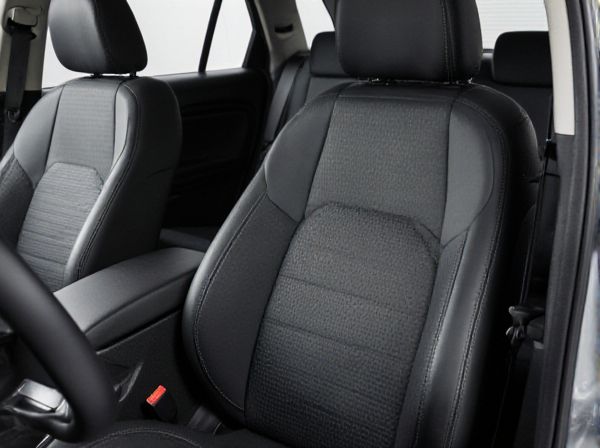
Photo illustration: Sport Seat vs Comfort Seat
Sport seats provide enhanced lateral support and firmer cushioning to keep you stable during aggressive driving, ideal for performance enthusiasts. Comfort seats prioritize plush padding and ergonomic design to reduce fatigue on long journeys, ensuring a relaxed driving experience. Choosing between a sport seat and a comfort seat depends on whether you value driving dynamics or everyday comfort most.
Table of Comparison
| Feature | Sport Seat | Comfort Seat |
|---|---|---|
| Design | Ergonomic with enhanced side bolsters for aggressive driving support | Plush cushioning with wide seating surface for relaxed driving |
| Material | High-grip fabric or leather with perforations for breathability | Soft leather or premium fabric focusing on comfort |
| Adjustability | Manual or electric with limited recline to maintain driver posture | Electric multi-way with lumbar support and headrest adjustments |
| Support | Firm padding targeting lateral and thigh support | Balanced padding emphasizing overall comfort and cushioning |
| Ideal Usage | Performance driving, track days, spirited driving | Daily commuting, long-distance travel, casual drives |
| Price Range | Mid to high | Mid to premium |
Understanding Sport Seats: Key Features
Sport seats feature enhanced lateral support with bolstered sides to keep the body securely in place during aggressive driving maneuvers. They typically incorporate firmer padding and contoured designs to improve driver stability and feedback, promoting better posture and control. Materials like Alcantara or perforated leather are commonly used to balance grip and breathability, making sport seats ideal for performance-oriented vehicles.
Comfort Seats Explained: Design and Benefits
Comfort seats prioritize ergonomic design with enhanced cushioning and lumbar support to reduce fatigue during long drives. High-quality materials such as memory foam and breathable fabrics improve ventilation and maintain optimal body temperature. These seats often feature adjustable settings that promote proper posture, contributing to overall driving comfort and wellness.
Ergonomics: Comparing Support and Posture
Sport seats offer enhanced lumbar support and firmer cushioning tailored to maintain optimal posture during dynamic driving, reducing fatigue by stabilizing the spine and hips. Comfort seats prioritize plush padding and broader surface areas, providing a softer feel that invites relaxation but may compromise long-term posture alignment. Ergonomic design in sport seats centers on minimizing lateral movement, while comfort seats emphasize pressure distribution for extended sitting ease.
Material Differences: Sport vs Comfort Seats
Sport seats typically feature high-performance materials such as reinforced leather or Alcantara, designed to provide enhanced grip and durability during aggressive driving. Comfort seats prioritize softer, more breathable fabrics or premium leather with added cushioning to maximize long-term comfort and reduce fatigue. The material selection in sport seats emphasizes resilience and support, whereas comfort seats focus on plushness and temperature regulation.
Adjustability and Customization Options
Sport seats offer enhanced adjustability and customization options tailored for dynamic driving, featuring adjustable side bolsters, lumbar support, and often integrated thigh extensions for superior lateral support. Comfort seats prioritize ergonomic design with extensive adjustments, including multi-way electric controls, memory settings, and heating or cooling functions to maximize passenger comfort. Both seat types use advanced materials but differ in emphasis: sport seats optimize fit and stability during aggressive maneuvers, while comfort seats focus on personalized cushioning and posture support for long trips.
Impact on Driving Experience
Sport seats enhance the driving experience by providing superior lateral support and a firmer cushion, promoting better posture and stability during aggressive cornering and high-speed maneuvers. Comfort seats prioritize cushioning and adjustability, offering a plush, supportive ride ideal for long-distance travel and everyday driving. The choice impacts handling precision and fatigue levels, with sport seats improving control but potentially compromising comfort, while comfort seats enhance relaxation at the expense of dynamic responsiveness.
Long-Distance Comfort: Which Seat Wins?
Comfort seats excel in long-distance comfort by providing superior cushioning, lumbar support, and adjustable features designed to reduce fatigue over extended periods. Sport seats prioritize lateral support and a snug fit to enhance driving dynamics but often sacrifice some plushness and adjustability, potentially leading to discomfort on long journeys. For drivers prioritizing sustained comfort on long trips, comfort seats offer a clear advantage in ergonomic design and pressure distribution.
Aesthetics: Styling for Sportiness vs Luxury
Sport seats feature aggressive bolstering, vibrant colors, and contrast stitching to emphasize a dynamic, performance-oriented aesthetic. Comfort seats prioritize plush materials, subtle stitching, and neutral tones that exude elegance and luxury. The design of sport seats highlights athleticism, while comfort seats focus on refinement and sophisticated styling.
Price Comparison: Sport vs Comfort Seats
Sport seats typically cost 20-40% more than comfort seats due to advanced materials, enhanced bolstering, and performance-oriented design features. Comfort seats prioritize cushioning and ergonomic support, often resulting in lower production costs and a more affordable price point. Price variations also depend on brand, vehicle model, and optional features like heating or ventilation systems.
Choosing the Right Seat for Your Needs
Sport seats offer enhanced lateral support and firmer cushioning designed to hold the driver securely during dynamic driving, making them ideal for enthusiasts who prioritize performance and road feedback. Comfort seats prioritize softness, adjustability, and ergonomic features to provide long-lasting comfort, perfect for daily commuting and long-distance travel. Assessing your driving style and priorities ensures selecting between sport and comfort seats aligns with your needs for either spirited driving or relaxed journeys.
 caratoz.com
caratoz.com